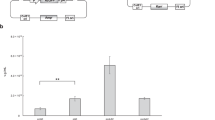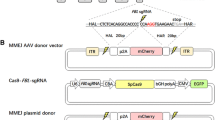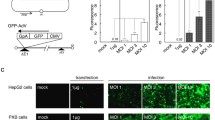Abstract
The plasmid vectors currently used for nonviral gene transfer have the disadvantage of carrying a bacterial backbone and an antibiotic resistance gene, which may cause side effects. The adeno-associated virus (AAV) genome is a linear single-stranded DNA (ssDNA) molecule with palindromic inverted terminal repeat (ITR) sequences forming double-stranded DNA (dsDNA) hairpin (HP) structures at each end. Based on the AAV genome, we constructed an AAV-ITR ssDNA minivector that consists of a GFP expression cassette flanked by both ITR sequences of 125 nucleotides. The minivectors were produced by digestion of the parental plasmids followed by denaturation. The self-complementary inverted T-shaped HP structure of the minivector was automatically formed. The HEK 293T cells were transfected with the AAV-ITR ssDNA minivector, plasmid, and dsDNA expression cassette. The results showed that AAV-ITR ssDNA minivector had relatively low gene expression efficiency in vitro. However, we found that the GFP expression efficiency of the D sequence-deleted AAV-ITR ssDNA minivector was significantly increased and was similar to those obtained with the plasmid and dsDNA expression cassette. Our data suggest that the AAV-ITR ssDNA minivector may be a new type of gene expression vector for gene therapy besides the virus and plasmid.






Similar content being viewed by others
Abbreviations
- AAV:
-
Adeno-associated virus
- ITR:
-
Inverted terminal repeat
- HP:
-
Hairpin
- ssDNA:
-
Single-stranded DNA
- dsDNA:
-
Double-stranded DNA
- pUC57-minivector:
-
The plasmid consists of the double-stranded DNA expression cassette flanked by two AAV inverted terminal repeats (ITRs)
- pUC57-minivector-EGFP:
-
The plasmid consists of the GFP expression cassette flanked by two AAV inverted terminal repeats (ITRs) (as the parent plasmid)
- ds-minivector-EGFP:
-
The double-stranded GFP expression cassette
- AAV-ITR ssDNA minivector:
-
The single-strand minivector consists of the DNA expression cassette and two palindromic ITR sequences
- AAV-ITR-3′ m ssDNA minivector:
-
The minivector with a 3′-end mutation
- AAV-D△-ITR ssDNA minivector:
-
D sequence-deleted AAV-ITR ssDNA minivector
References
Lyon, A. R., Sato, M., Hajjar, R. J., Samulski, R. J., & Harding, S. E. (2008). Gene therapy: Targeting the myocardium. Heart, 94, 89–99.
Somia, N., & Verma, I. M. (2000). Gene therapy: Trials and tribulations. Nature Reviews Genetics, 1, 91–99.
Couzin, J., & Kaiser, J. (2005). Gene therapy. As Gelsinger case ends, gene therapy suffers another blow. Science, 307, 1028.
Gao, X., Kim, K. S., & Liu, D. (2007). Nonviral gene delivery: What we know and what is next. The AAPS Journal, 9, 92–104.
Gill, D. R., Pringle, I. A., & Hyde, S. C. (2009). Progress and prospects: The design and production of plasmid vectors. Gene Therapy, 16, 165–171.
Schwartz, D. A., Quinn, T. J., Thorne, P. S., Sayeed, S., Yi, A. K., & Krieg, A. M. (1999). CpG motifs in bacterial DNA cause inflammation in the lower respiratory tract. Journal of Clinical Investigation, 100, 68–73.
Jechlinger, W. (2006). Optimization and delivery of plasmid DNA for vaccination. Expert Review of Vaccines, 5, 803–825.
Levy, M. S., O’Kennedy, R. D., Ayazi-Shamlou, P., & Dunnill, P. (2000). Biochemical engineering approaches to the challenges of producing pure plasmid DNA. Trends in Biotechnology, 18, 296–305.
Lengsfeld, C. S., & Anchordoquy, T. J. (2002). Shear-induced degradation of plasmid DNA. Journal of Pharmaceutical Sciences, 91, 1581–1589.
Jechlinger, W., Azimpour, T. C., Lubitz, W., & Mayrhofer, P. (2004). Minicircle DNA immobilized in bacterial ghosts: In vivo production of safe non-viral DNA delivery vehicles. Journal of Molecular Microbiology and Biotechnology, 8, 222–231.
Chen, Z. Y., He, C. Y., Meuse, L., & Kay, M. A. (2004). Silencing of episomal transgene expression by plasmid bacterial DNA elements in vivo. Gene Therapy, 11, 856–864.
Chen, Z. Y., He, C. Y., & Kay, M. A. (2005). Improved production and purification of minicircle DNA vector free of plasmid bacterial sequences and capable of persistent transgene expression in vivo. Human Gene Therapy, 16, 126–131.
Darquet, A. M., Cameron, B., Wils, P., Scherman, D., & Crouzet, J. (1997). A new DNA vehicle for nonviral gene delivery: Supercoiled minicircle. Gene Therapy, 4, 1341–1349.
McCarty, D. M. (2008). Self-complementary AAV vectors; advances and applications. Molecular Therapy, 16, 1648–1656.
Penaud-Budloo, M., Le Guiner, C., Nowrouzi, A., Toromanoff, A., Chérel, Y., Chenuaud, P., et al. (2008). Adeno-associated virus vector genomes persist as episomal chromatin in primate muscle. Journal of Virology, 82, 7875–7885.
Yiang, G. T., Chou, R. H., Chang, W. J., Wei, C. W., & Yu, Y. L. (2013). Long-term expression of rAAV2-hIL15 enhances immunoglobulin production and lymphokine-activated killer cell-mediated human glioblastoma cell death. Molecular and Clinical Oncology, 1, 321–325.
Ferrari, F. K., Samulski, T., Shenk, T., & Samulski, R. J. (1996). Second-strand synthesis is a rate-limiting step for efficient transduction by recombinant adeno-associated virus vectors. Journal of Virology, 70, 3227–3234.
Fisher, K. J., Gao, G. P., Weitzman, M. D., DeMatteo, R., Burda, J. F., & Wilson, J. M. (1996). Transduction with recombinant adeno-associated virus for gene therapy is limited by leading-strand synthesis. Journal of Virology, 70, 520–532.
Duan, D., Sharma, P., Yang, J., Yue, Y., Dudus, L., Zhang, Y., et al. (1998). Circular intermediates of recombinant adeno-associated virus have defined structural characteristics responsible for long-term episomal persistence in muscle. Journal of Virology, 72, 8568–8577.
Schnepp, B. C., Jensen, R. L., Chen, C. L., Johnson, P. R., & Clark, K. R. (2005). Characterization of adeno-associated virus genomes isolated from human tissues. Journal of Virology, 79, 14793–14803.
Xiao, X., Li, J., & Samulski, R. J. (1996). Efficient long-term gene transfer into muscle tissue of immunocompetent mice by adeno-associated virus vector. Journal of Virology, 70, 8098–8108.
Lusby, E., Fife, K. H., & Berns, K. I. (1980). Nucleotide sequence of the inverted terminal repetition in adeno-associated virus DNA. Journal of Virology, 34, 402–409.
Ni, T. H., Zhou, X. H., McCarty, D. M., Zolotukhin, I., & Muzyczka, N. (1994). In vitro replication of adeno-associated virus DNA. Journal of Virology, 68, 1128–1138.
Wang, X. S., Ponnazhagan, S., & Srivastava, A. (1995). Rescue and replication signals of the adeno-associated virus 2 genome. Journal of Molecular Biology, 250, 573–580.
Qing, K., Khuntirat, B., Mah, C., Kube, D. M., Wang, X. S., Ponnazhagan, S., et al. (1998). Adeno-associated virus type 2-mediated gene transfer: correlation of tyrosine phosphorylation of the cellular single-stranded D sequence-binding protein with transgene expression in human cells in vitro and murine tissues in vivo. Journal of Virology, 72, 1593–1599.
Zhong, L., Qing, K., Si, Y., Chen, L., Tan, M., & Srivastava, A. (2004). Heat-shock treatment-mediated increase in transduction by recombinant adeno-associated virus 2 vectors is independent of the cellular heat-shock protein 90. Journal of Biological Chemistry, 279, 12714–12723.
Acknowledgments
This work was supported by the National Natural Science Foundation of China (Grant No. 81371670 and 3097880), the Natural Science Foundation of Jiangsu Province (Grant No. BK2012629).
Author information
Authors and Affiliations
Corresponding author
Additional information
Han Ping and Xiaomei Liu have contributed equally as first authors.
Rights and permissions
About this article
Cite this article
Ping, H., Liu, X., Zhu, D. et al. Construction and Gene Expression Analysis of a Single-Stranded DNA Minivector Based on an Inverted Terminal Repeat of Adeno-Associated Virus. Mol Biotechnol 57, 382–390 (2015). https://doi.org/10.1007/s12033-014-9832-3
Published:
Issue Date:
DOI: https://doi.org/10.1007/s12033-014-9832-3




